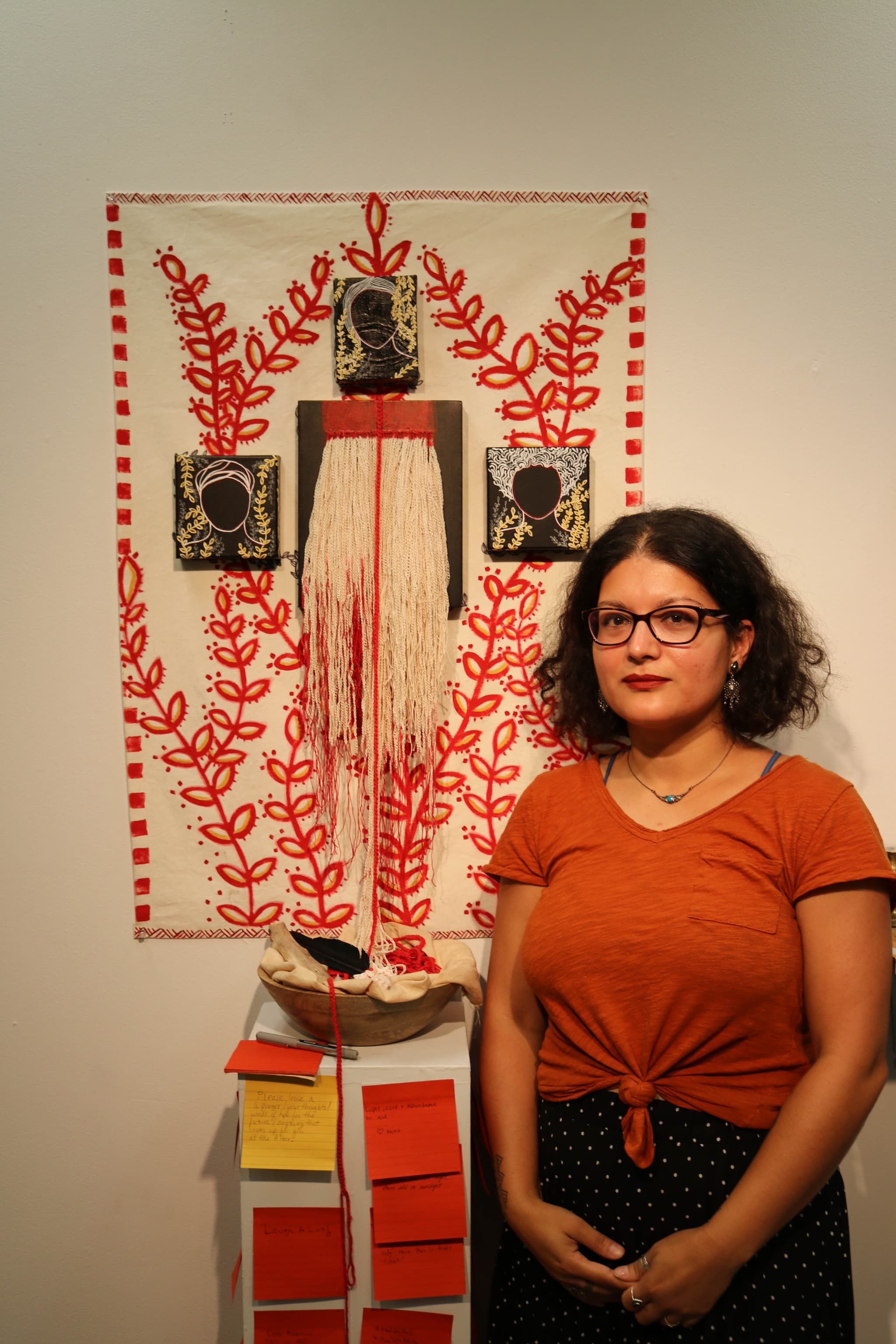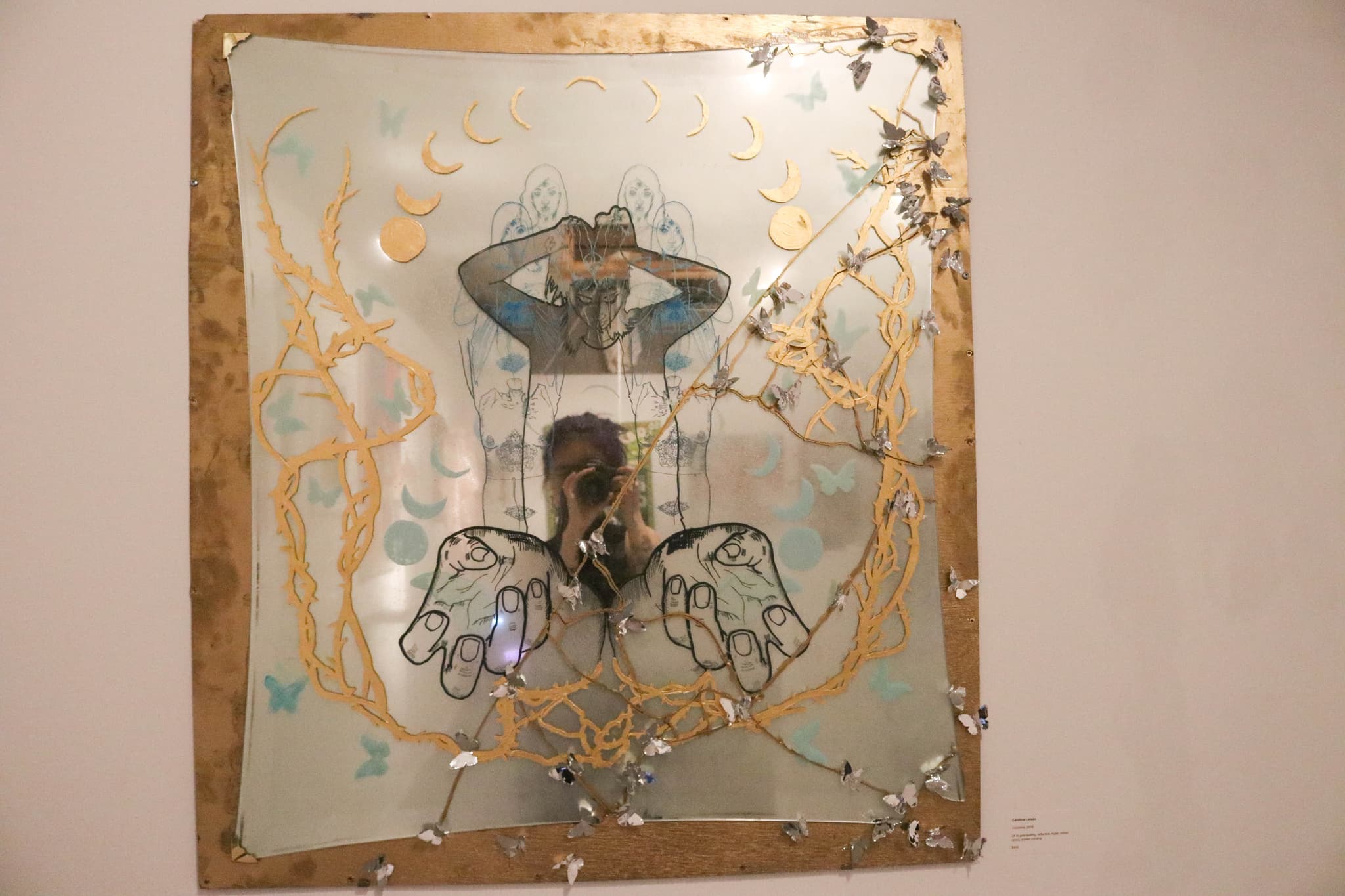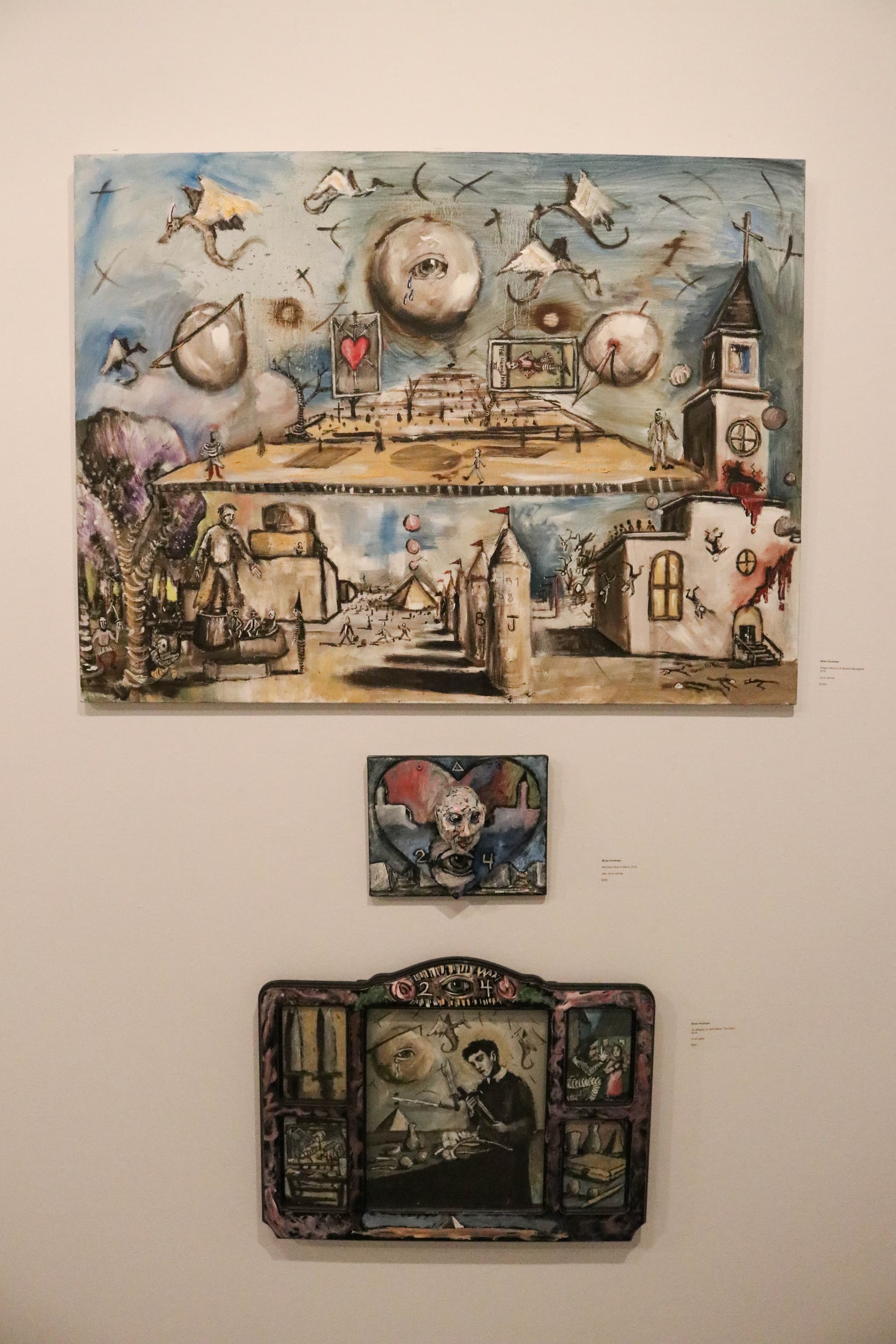Sacred takes on a different definition for each individual—what people value is shaped by a unique combination of experiences, memories, and ideas. For Dorchester Art Project’s “Altarations: A Selection of Shrines,” artists constructed shrines to express what they hold sacred. The show, curated by DAP gallery manager Emma Leavitt and gallery director Sophia Giordano, is hosting a closing reception on August 26, 1-4pm at DAP. While there are over 80 total shrines housed inside the DAP walls and hallways, it certainly feels like more. Walking through the space was similar to walking through a vintage and thrift store. I was greeted by an eclectic mix of artfully arranged objects: rat skeletons, a large television screen, branches, photos, paintings, a hanging mobile, and handwritten notes on Post-its, to name a few. The handwritten notes on Post-its plastered on a white poster is only one part of Ankana’s shrine. “Altar to the Nameless Migrants” is a tribute to the 3,741 migrants who lost their lives from January to August 2017. However, there’s more beyond the numbers, according to Ankana. “We talk about numbers, a lot of the time, we get lost in numbers and stats. And for me, even though those are important, numbers are important, I wanted to put a human face to it. These aren’t just numbers, these are people. We’re talking about lives lost. And so I wanted to do something to bring that to light,” she said. A cream-colored fabric hangs on the wall. On the fabric are vines painted in red and gold, and three outlines of faces painted on canvas mounted on top. The fabric hangs over a bowl of scavenged objects, which sits atop a post covered in Post-its from visitors who left their reactions to the piece. “My hope is that when people engage with my piece that they think critically and compassionately about migrants and migration,” she said. Hailing from Assam, India, Ankana said that the way the shrine is arranged reflects the culture she was raised in. “I was born in India so when we have somebody who passed away, the way we kind of honor them is having a portrait of them in a very central location of the house, usually the living room, and we surround it with plants and flowers and we’ll have certain items around the portrait. This is my way of doing that, representing the elements as well as these colors that I chose are very traditional for my background. The red, the yellow and gold, the cream white.” Ankana said she intentionally left the faces blank. By leaving them blank, she she demonstrates the commonality of the situation migrants face. “A lot of these folks, we don’t know who they are. We don’t know what they look like, we don’t even know names. So that was my reason for leaving it blank. It could be any face…A lot of the time we just don’t know who they are and where they came from. The exact reason why they left. A lot of the times the bodies are never found, never claimed,” Ankana said.
Online• Aug 26, 2018
The Dialectic Nature of Shrines at Dorchester Art Project
For Dorchester Art Project’s “Altarations: A Selection of Shrines,” artists constructed shrines to express what they hold sacred.
Feature by Olivia Deng
Ankana stands in front of her shrine "Altar to the Nameless Migrants." (Olivia Deng/Boston Art Review)

Ankana stands in front of her shrine "Altar to the Nameless Migrants." (Olivia Deng/Boston Art Review)

“Insomnia” by Carolina Laredo communicates a message about mental health, with references to her Peruvian heritage. (Olivia Deng/Boston Art Review)
Ankana is not the only artist whose shrine sends a message about immigrants. Carolina Laredo’s Peruvian roots are incorporated into her shrine called “Insomnia” that focuses working through personal challenges like mental health. Laredo affirmed much of her work is drawn from personal experiences. A dark figure looking down stands in front of six figures and behind two hands. This imagery is painted on large mirror framed in gold. Gold moon phases and vines surround the dark figure, as do silver butterflies. Laredo shared that her shrine was born from an anxiety attack. “I had a really bad anxiety attack and it has a lot to do with the fact that I feel like when I go through anxiety, I go through a time of not understanding myself,” she said. “So the idea for the main figure, if you look at all six figures that are behind it, they are actually inter-looping. You can see the hand, the face, actually [interwoven] with each body part. I think that has a lot to do with other anxiety that I deal with. Having that center figure is when you are going through these things, you don’t have just one feeling, there are multiple feelings that are racing through you and you feel like you have multiple different types of personalities when you’re experiencing these anxieties.” The butterflies that surround the figure represent how immigrants are viewed as butterflies, Laredo said. “I was going through a lot of things with school and also politically, my family’s from an immigrant family so I wanted to have a conversation about immigration…I also wanted to talk about the idea like how immigrants are seen as butterflies. The transparency, the mylar shows you’re able to reflect yourself in it. No one besides actually indigenous people from this continent are people from here so I wanted to have that idea as well come through that.” While the butterflies represent movement, the hands painted in black are tied down by thorny vines. Laredo shared that, “to be able to grasp something and to be able to let go is a huge thing that I think in society we deal with. You also see the hands are wrapped with thorn-like things coming out of it. I wanted to show the idea that thorns, they’re not only something that tie you down, but also strengthen you. Even though these thorns are things in life are holding you, you’re able to release pains and anxieties.”

Brian Huntress’ oil paintings featuring the Catholic imagery from his childhood also reclaim the negative aspects he said he was raised with. (Olivia Deng/Boston Art Review)
Growth is a theme also explored by Brian Huntress, whose shrine consists of three oil paintings with a dark palette. His work recalls his troubled childhood, but also re-appropriates and reclaims the aspects that brought him pain. “In those specific three pieces, I used a lot of Catholic imagery. Even some quasi Masonic stuff. I was raised Catholic. I was kind of indoctrinated with a lot of these beliefs at a young age, which I really do not hold anymore. I’m not a Catholic,” Huntress clarified. “In a lot of ways, through the church I was raised in and being around all these symbols, I was taught to hate myself. One of the first things I learned at a very young age was how to be ashamed of myself…I learned how to be ashamed, I learned how to hate, I learned how to alienate myself from others.” The shrines, like much of Huntress’ other work, are dark and often reflect a turbulent past. While some may want to ignore the past, Huntress remarked that those formative years taught him how to question and think critically, and were therefore valuable. “For me personally, the hatred, pain, and suffering that I’ve experienced was the very thing that made me me. I live with these things everyday but they’re not things that plague me or haunt me or destroy the way I live. They’ve absolutely colored, informed, and painted the way I interact with the rest of the world…These things have taught me how to scrutinize, how to be skeptical in a healthy way,” Huntress said. “I feel like at this point, a lot of times in my work, I lift a lot of symbolism from those places. I reappropriate it. I guess just reclaim a lot of it…those shrines are the things I was taught, things I unlearned, I guess reappropriating those things and trying to make them more palatable and beautiful and present them in a way that helps me grow as a person and understand myself more.”

Maria Molteni’s “Ruina Avem Maris / Fall of a Sea Bird” pays tribute to the Our Lady of Good Voyage Chapel, incorporating remnants from the chapel. (Olivia Deng/Boston Art Review)
One of the most explicitly site-centric pieces is Maria Molteni’s tribute to Our Lady of Good Voyage Chapel. Built in the 1950s, the chapel was a space for migrants. An artist and beekeeper who grew up in Nashville, Molteni’s artwork is shaped by her advocacy for womxn and frequently focuses on matriarchal alarm systems. “…Recontextualizing the idea of Sirens as mythical women who lead sailors to their peril. I think a lot about matriarchal societies from Shakers to honeybees and how we should listen to their warnings as our environment spins out of control,” she said. Her shrine features remnants from the chapel, scavenged objects from Boston Harbor and its islands. Molteni clarified that, “Ruina Avem Maris’ simultaneously manifests an immortalizing flight and mournful burial at sea, echoing the mantra “as above so below.” She added that she hopes viewers do not just passively look at her shrine, but engage with it. “I hope they feel a flutter in their belly or a pulsing in their eyes. When I look at artwork I’m inspired by, I get hungry for my own work right then and there. Like I’ll be magnetized to the piece and itching to get back to my studio. I guess I hope the piece inspires its viewer to engage more deeply with whatever they are passionate about when they go home to their own studios, shrines, spaces,” Molteni said. At the show opening, participants had the opportunity to create shrines of their own. Facilitated by Holly Czapski, Owner/Designer at Mac&Craft, participants made shrines out of empty cereal and cracker boxes, decorating them with markers and images cut from magazines and old books. The participatory component in art is empowering, Czapski noted. Recalling the event, Czapski spoke about the power of collective art making. “As to what people get out of participatory art, I would say: agency and empathy. I think most people think they can’t make art. They can enjoy it at museums but, like shoes, it isn’t something normal people can make themselves,” She affirmed. “So the experience of making art and crossing that divide is empowering. The flip side is once you’ve tried to make art, you start to understand what’s involved. So the experience of making art in turn makes you a more empathetic art viewer.”
